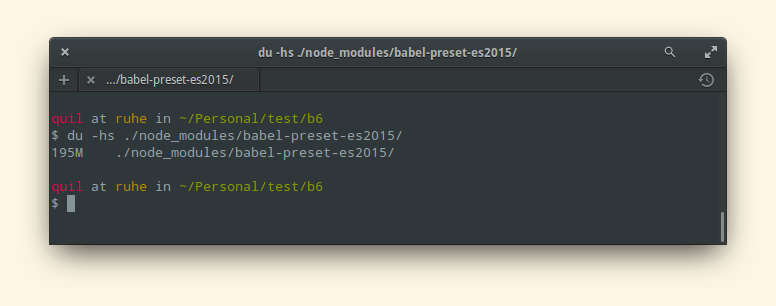No, I Don't Want To Configure Your App!
Warning
This blog post is a rant. A very. opinionated. long. and angry. rant.
Table of Contents
- What’s in an Application?
- The way we think about Apps is wrong
- Applications are about experience
- How do we solve this?
- Conclusion
- Related articles/stuff
There seems to be a very interesting trend re-emerging in software development lately, influenced by Node’s philosophy, perhaps, where to use anything at all you first need to install a dozen of “dependencies,” spend the next 10 hours configuring it, pray to whatever gods (or beings) you believe in—even if you don’t. And then, if you’re very lucky and the stars are properly aligned in the sky, you’ll be able to see “Hello, world” output on the screen.
Apparently, more configuration always means more good, as evidenced by new, popular tools such as WebPack and Babel.js’s 6th version. Perhaps this also explains why Java was such a popular platform back in the days.
Hypothesis The popularity of a tool is proportional to the amount of time it makes their users waste.
What’s in an Application?
Before we proceed with our very scientific analysis of why programming tools suck completely (or well, most applications, really1), let us revisit some of the terminology:
-
Library, a usually not-so-opinionated solution for a particular problem. Libraries do things, and they allow you to configure how things get done. They also allow you to combine stuff to do more things. Of course, you pay the price of having to configure, program, and combine things. And they won’t help you get any of those three done.
-
Framework, an opinionated solution for a particular problem. Frameworks do things in a very specific way, which the author considered to be good enough for the particular problem they solve. Frameworks can’t be combined. They can’t be configured. The only thing you can do is program on top of them. A framework helps you very little with programming on top of them, unless you stick close to whatever people have already done before—but then why are you doing those same things again?
-
Application, an opinionated, properly packaged, usable-out-of-the-box solution for a particular problem. Applications do things in one way, and one way only. You can’t change that. You can’t combine them. You can’t configure them. You can’t program on top of them. Applications just get the job done. They’re like the coffee machine on the office: you press the button, delicious coffee magically appears in your cup.
Given these definitions, we can only conclude that neither WebPack nor Babel fit the definition of an Application, they hardly fit the definition of Framework either, so that only leaves us with Library.
This is hardly surprising considering that these tools come from the same community that defines “transpiler” in the same way “compiler” is defined in literature, then says the words are not synonymous.
Hypothesis Programmers don’t know the meaning of words.
The way we think about Apps is wrong
The title says it all. My job here is done. Thank you for reading.
Or maybe I can be a little more helpful. Let’s see…
Applications are about experience
Let’s go back to the coffee machine analogy for a second.
These are very neat machines. They have one button that says “Get Coffee”. You press it, things happen, you get your coffee.

You are happy and gay.

But… what if you want your coffee in a different way? The coffee machine could add more buttons. Maybe a button where you select if your coffee will have sugar or not. Maybe a button where you select the amount of milk you want to put in your coffee. Maybe a button where you select if you want cream or not. Maybe a button where you can get tea instead of coffee! Maybe…
At this point people have to do so many things to even get something to drink that it feels just as overwhelming as brewing coffee yourself. Not only that, you now need a manual just to operate the machine.

Sadness and frustration fill what seems to be a way too tiny body for the amount of negative feelings this evokes.

If you compare the experience of using both coffee machines, even if the former doesn’t give you the exact kind of coffee you want, you are still far better off.
Hypothesis Humans are bad with choices, and they’d rather not make them.
Even though this is common knowledge, computer applications still insist in being the latter. We can compare how it feels to use Babel v5 against how it feels to use Babel v6.
This is Babel v5:
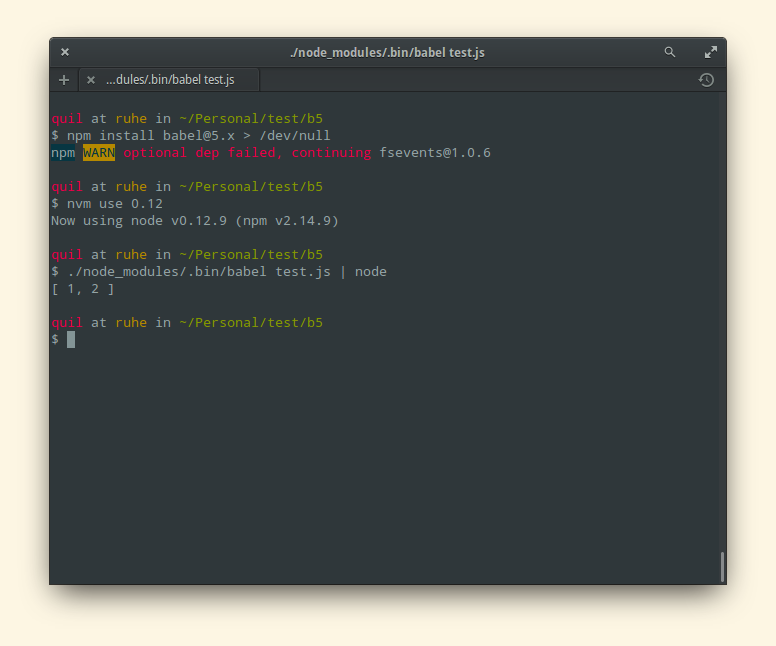 Things with Babel v5 Just Work™
Things with Babel v5 Just Work™
And this is Babel v6:
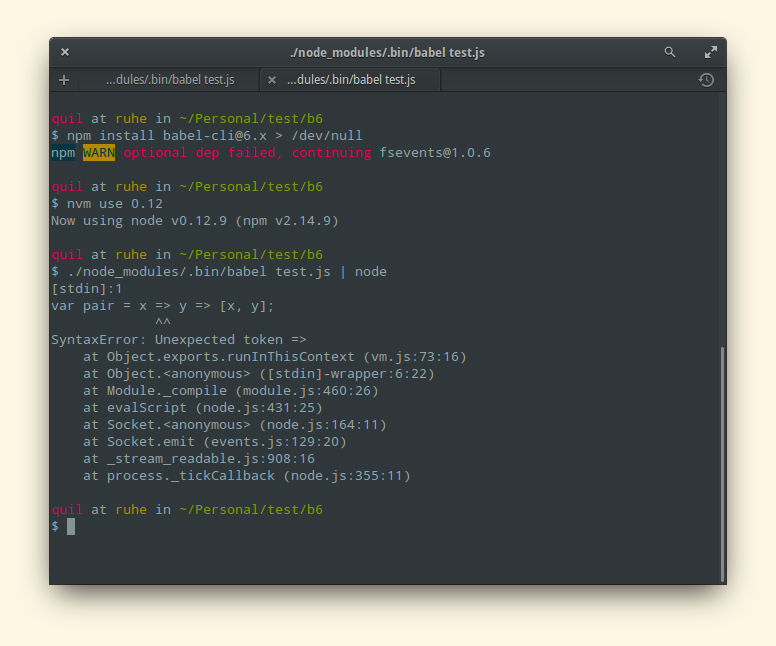 W-What is this even supposed to mean?
W-What is this even supposed to mean?
So, as you can see, not only does Babel v6 not work at all, it still leads to cryptic errors that give you no insight into how to solve the problem.
Hypothesis Programmers don’t know how to help people fix things.
What do you do? Well, you ask around the Internets why something that
should work is not working. You spend time doing that. You have to read
the documentation of a thing that just says in its --help command
"Usage: babel [options] <files ...>".
Once you get around to reading the documentation, you’ll discover that,
even though you should have installed an ES6→ES5 compiler by running
npm install babel-cli, to get the compiler to work, you have to
actually install the compiler:
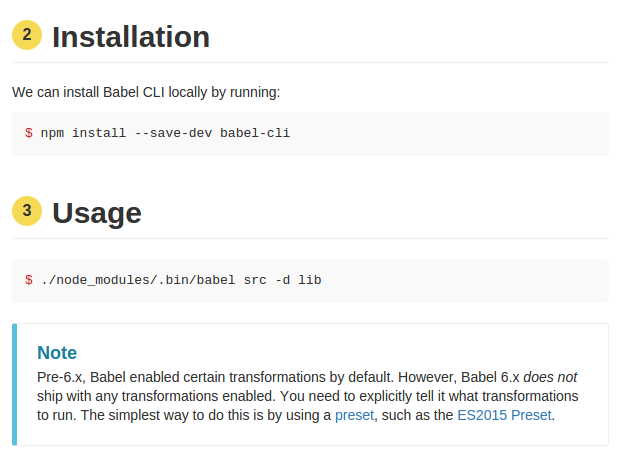 I have no words
I have no words
Hypothesis Programmers are just terrible with logic.
So, after reading the two links provided in that note (one of which tells you absolutely nothing about how to solve the problem you just saw, and only serves to make you more confused and frustrated), you install 200MB worth of data2 just to compile arrow functions and array spreads so they actually work in your environment. You also need to create some kind of text file that you have no idea where to, which format, or how it gets used, because nothing anywhere in the linked pages (or any page in the documentation) says a thing about it.
Did I mention that we’re supposed to just accept all of this as “that’s the way things are” because goddesses forbid you complain about it? Okay, cool.
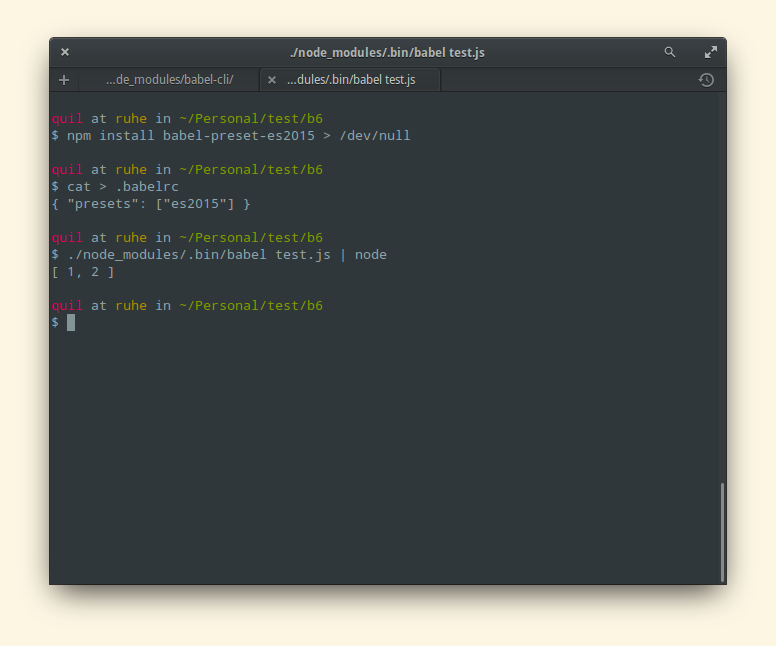 Things apparently work maybe who knows
Things apparently work maybe who knows
So, what was so wrong with the previous Babel approach that they thought this was a good idea? Well, nothing really. They could have just as easily added a way to configure the program if you wanted to opt-out of something, but instead they decided to burden everyone with making the choice they had already made by installing Babel in the first place.
How do we solve this?
So, how do you create applications that don’t suck, and make your users want to never have known what a computer is? Well, the Human Interface Guidelines from ElementaryOS are a very great place to start. If you copy everything there, even if you don’t design an ElementaryOS application, your application will likely be actually usable by human beings.
I can’t stress the human part of “human-computer interfaces” enough. Please, think about humans when you’re designing something that you want them to use.
Hypothesis Programmers employ robots in their HCI tests.
(T-They do tests to at least figure out if their things are usable, right…?)
1. Convention over configuration
The ideal application is one that works out of the box. No configuration needed. No way of wasting time. Sometimes certain pieces of data are necessary to get the application get up and running. What do you do?
Rule #1: If I need to configure your application, you’re doing it wrong.
“Uh, ask the user to provide that information?”
That’s the one thing you do not do. Most likely this information is already available for you:
-
“I need the user’s github repository so I can present a list of issues whenever they—” parse it from Git or whatever other thing you can (
package.jsonalready has that information!); -
“I need the user’s name so I can associate it with—” ask the OS for that information.
-
“I need the directory where people put their dependencies so—” come up with a convention for it,
node_modulesin Node is a great one. Use it. -
“I need people to provide a tool to open .xyz f—” associate the extension with external tools, suggest to download and install said tool whenever you see a
.xyzfile. -
“But I—” GET THAT INFORMATION FROM SOMEWHERE ELSE.
Okay, sometimes there are pieces of information that aren’t already available somewhere in the computer. “For those cases I just ask the user to provide it… right?” That depends, is it absolutely required that the user provide such information in order to run the application at all? If so, you’re probably doing something wrong. Try packaging all of the things that are required to run your application together, instead.
“But at some point in time people will need a different configuration profile, and—” sure. Give them a tool to configure that if and when they absolutely need to, and guide them through choosing the best settings for their use case. Just don’t use configuration files. Don’t require your users to edit configuration files by hand.
2. Hold your user’s hand through using your app
Ideally, an application should work by just running it. Sometimes,
however, that’s not really possible. Consider the nvm application, for
example. It’s a tool to manage Node versions, so how would it know what
version you want to use if you don’t provide it?
Rule #2: If you really need to, hold your user’s hands through using your app.
If you type nvm in the command line, you’ll be presented with an
overwhelming amount of information:
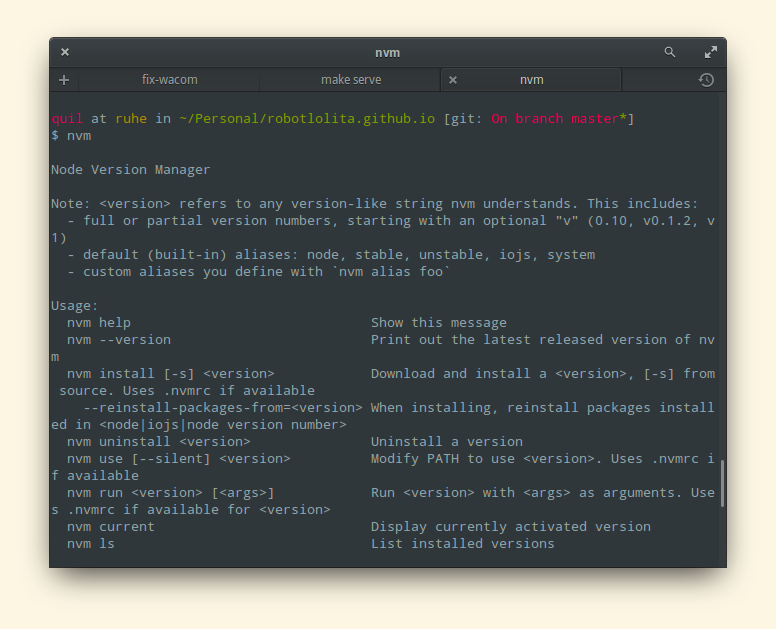 This is seriously too much. It doesn’t even fit in one screen
This is seriously too much. It doesn’t even fit in one screen
Worse than that, this text tells you nothing about how you can
start using the application. But there’s a nvm use <version> in
that list, and that’s exactly what you want, right? You just want to use a
particular version of Node. So you try it:
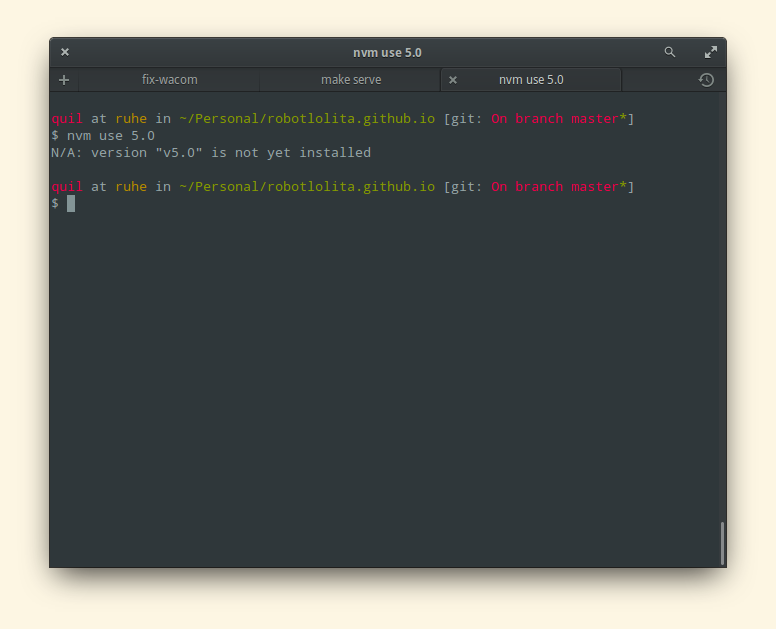 Uh… how do I use it, then?
Uh… how do I use it, then?
It says “version 5.0 is not yet installed”, which is not a very helpful thing to do. You’re there reading this as “Hey, there’s a problem,” and waiting for it to tell you something besides the obvious. You shout back “Okay, I know that, but how do I fix it?” Nothing happens. So what do you do? You read more things.
Back to the first wall of text, there does seem to be something like
nvm install <version> in the list. It at least seems to fit the
cryptic error description above, so maybe they are related? You
don’t know, the text doesn’t tell you in which order you have to run
things (why separate things in steps at all if you need to run all of
them anyway?!).
“Okay, lemme try this one.”
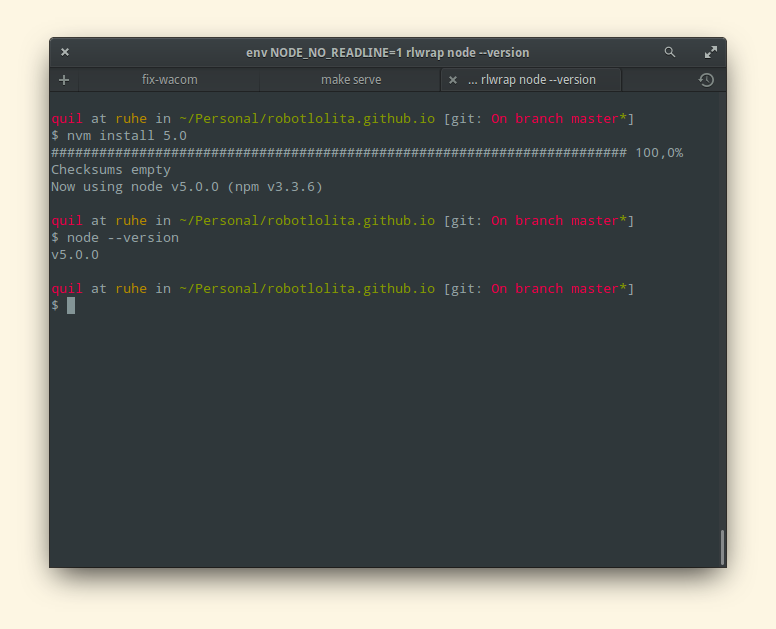 Wow, am I supposed to just run
Wow, am I supposed to just run install?
You ponder a bit about why the application decided that it was a good idea to include two commands that do the same thing, but only one which works. Nevertheless, you settle for the fact that things (at least apparently) work now.
And then you open a new shell to run a different application, so of course that application also depends on Node, and:
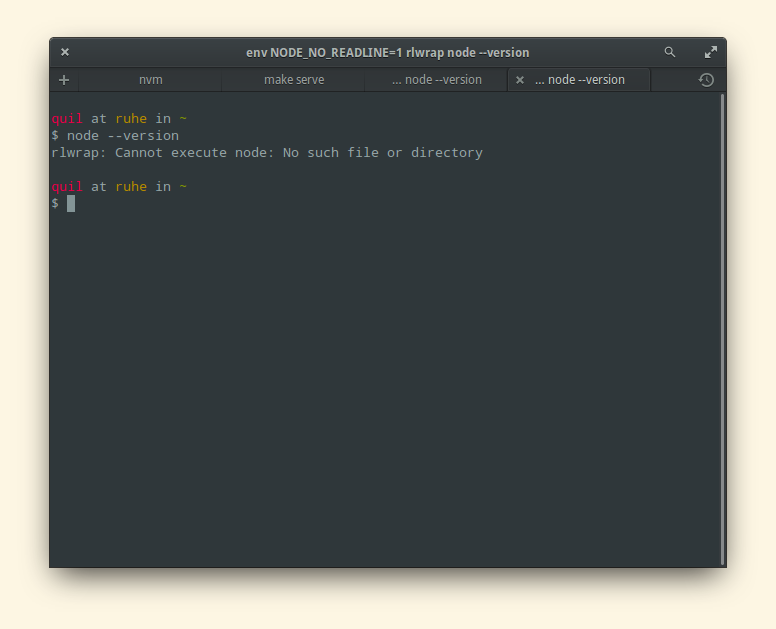 But… it was working just fine a couple of seconds ago!
But… it was working just fine a couple of seconds ago!
You stare blankly at your screen trying to understand what just
happened. Node was working just fine, and then it wasn’t. Maybe nvm is
just terrible and breaks randomly? You decide to try node --version in
the other shell, which to your surprise gives you what you expect:
v5.0.0. “Am I just supposed to run nvm install <version> in every
shell I open!?”
You decide to run nvm install <version> again just to test your
theory:
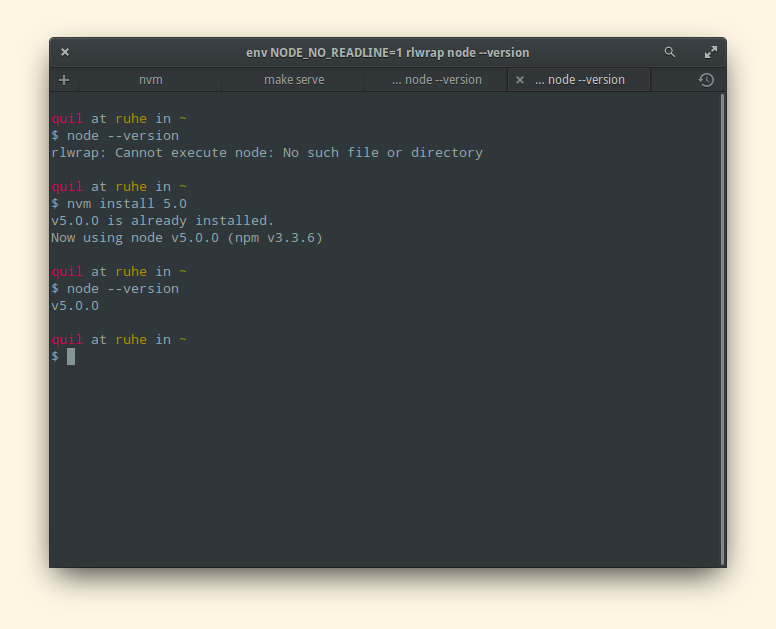 It works. Really?
It works. Really?
You’re flabbergasted. Never in your life you would have thought that people would try to make it so hard for one to use things on their computers. Then you remember your previous experience with Babel. “Okay, maybe they would,” you conclude, with a heavy sigh.
But there must be something else, right? They can’t just expect you
to run nvm install <version> all the time (actually nvm run <version>,
but you don’t know that, it didn’t seem to work for you when you tried).
You go back to the first wall of text, searching for anything that would
hint at not having to do this work all the time. nvm alias default <version>
catches your attention. It does mention “default. node. shell”, after
all. Those are, like, keywords, right? You decide to give it a try:
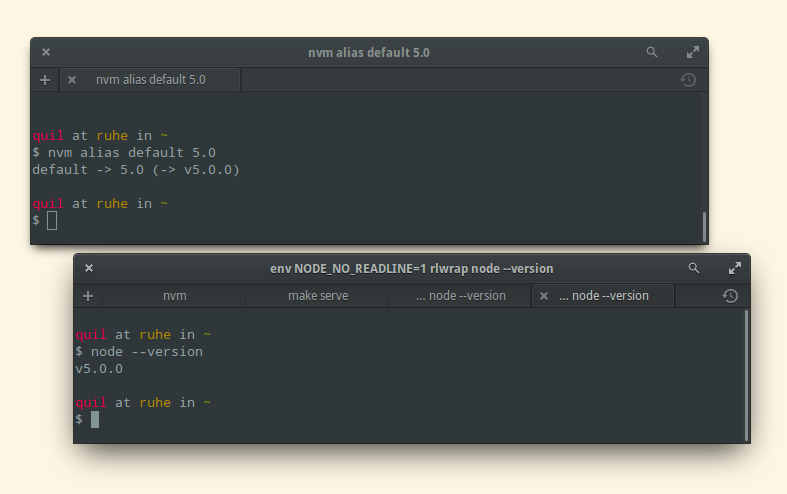 Welp, why would you require all this?
Welp, why would you require all this?
“Oh goddess, finally!” you exclaim, exasperated. You feel as if a major weight had been lifted from your shoulder, but you’re too frustrated with how bad computers are to think properly about this. “Now I can actually move on and get some work done,” you conclude, grumbling.
Could this have been different? Sure, let’s look at another quite possible interaction between the aforementioned human and nvm. Let’s assume that nvm decided that their goal is to help people manage their Node versions. With this goal in mind, nvm has traced a very common use case for new (and long-term) users of the application:
- You download the
nvmapplication because you wantnvmto install and configure different Node versions for you. - You care about having a default node version, after all, since nvm is going to be managing that.
- You care about running node with the least amount of commands
possible. Ideally you’d just write
nodeand things would work.
You start with running nvm. The application notices it can’t actually
get any work done for you, so it suggests some common actions:
 A more helpful way of telling your users they need to do something
A more helpful way of telling your users they need to do something
You note that it’s still necessary to configure nvm for it to work. An
interactive screen where the application suggests installing the
stable version for you (which is a good default) would allow you to be
done with this configuration biz faster. Nonetheless, this is already
a huge improvement over the previous screen. It at least tells you
what you have to do to get it working.
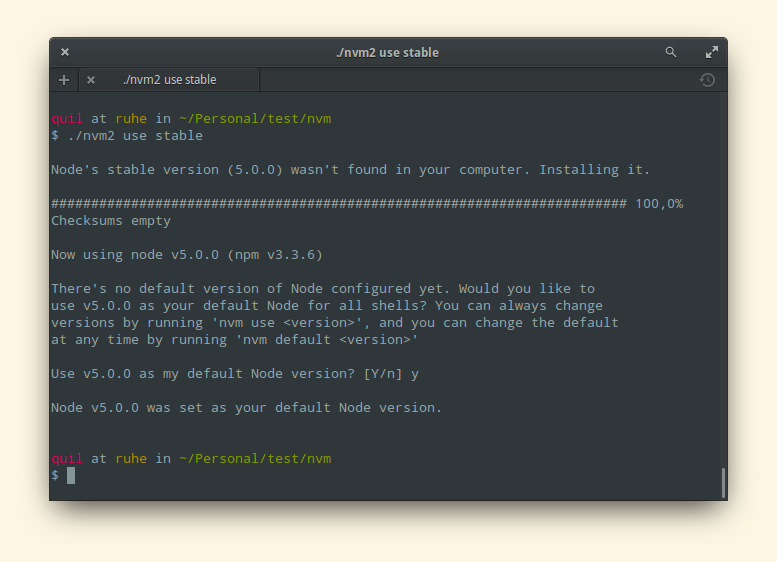 One command to rule them all
One command to rule them all
Oops, you didn’t have any version of Node installed before running
use. But the command acknowledged so and installed the version for
you. It was the only sensible thing to do, there was nothing else that
could be done there.
A quick reminder When your application sees an error, and there’s only one way to fix it, fix it.
After installing it, you’re asked if you’d like to make the version we
just installed your default Node version. It dutifully notes that you
can change it at any point in time, if you want to. Running npm use <version>
is a common thing to do—it’s the whole point of the
application. Given this, it’s only reasonable to give you an option
of reducing that work.
“B-But this doesn’t apply to every program, right? How do you do this for a programming language’s implementation?” An application developer cries. Well, here’s an example from Amber Smalltalk
 Interactive tutorials for learning PLs are a really good idea
Interactive tutorials for learning PLs are a really good idea
3. Things will fail, tell me how to fix it!
The best way of handling unexpected actions in your application is just fixing it for the user and proceeding to do what the user wants—if you can solve it in a sensible manner. This is not always possible, however.
Rule #3: If anything goes wrong, you must help your users fix those problems in the best way possible.
Consider the following example:
 v8 has one of the worst error messages I’ve ever seen
v8 has one of the worst error messages I’ve ever seen
So, JSON.parse() says “Sorry, I can’t parse this, there’s a b
here”. A b WHERE?! What should have been there? Do you realise there’s
like two b’s in this code? Which one is wrong? Are both wrong? How do
I fix this?
As you can see, v8’s error messages, even though they have improved a little bit, remain largely useless. This, in particular, is one of those errors that a little bit more of work on your JSON parser could actually give the user a very useful error message:
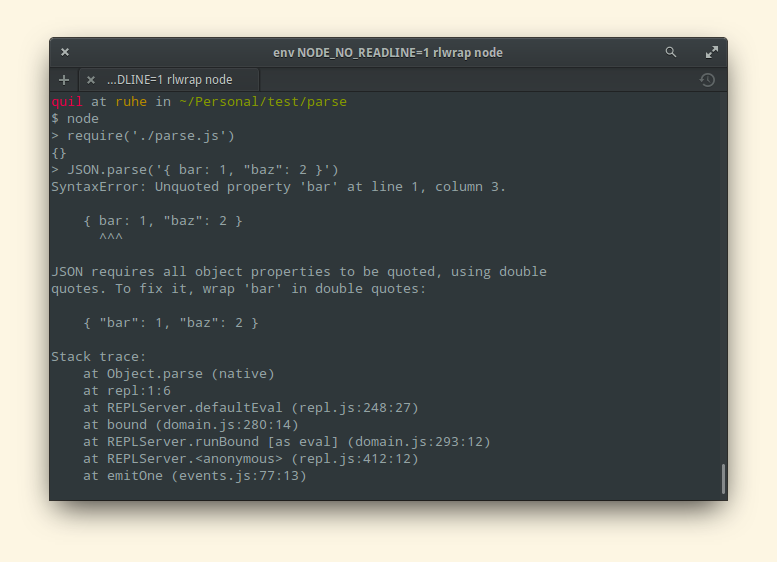 A few simple changes to the parser and you can get this
A few simple changes to the parser and you can get this
Now, not only the error message helps you understand what is wrong, it also tells you how to fix it. Telling the user how to fix something is desirable, but not always possible. Still, one has to at least make some effort to tell the user what’s wrong, in a way they can understand, instead just screaming “I’m sorry Dave, I can’t do that.”
Speaking of usable error messages, Elm has a very good blog post on the subject, and also one of the most helpful error messages, as far as static compilers go:
 The above image is shamelessly stolen from Elm’s blog post
The above image is shamelessly stolen from Elm’s blog post
4. Stop thinking about documentation!
Documentation is good for libraries and frameworks. Documentation is terrible for applications. If you think that your application really requires documentation, it’s too complicated, and it’s going to make your users frustrated.
This is true because it’s on XKCD:
 I rest my case
I rest my case
Instead of documentation, just have your application do its job by simply running it. No configuration. No nothing. Just let the user get the stuff done.
Rule #4: Don’t require users to read manuals before using your thing.
Apple gets it, you can just copy them:
Conclusion
Computers suck.
Applications suck.
We can make them better.
But y’all aren’t even trying for fuck’s sake.
(I’m guilty of this too)
Related articles/stuff
- Software You Can Use
- Glyph
- JavaScript Fatigue
- Eric Clemmons
- The Future of Programming
- Bret Victor
- A Whole New World
- Gary Bernhardt
- Self and Self: Whys and Wherefores
- David Ungar
